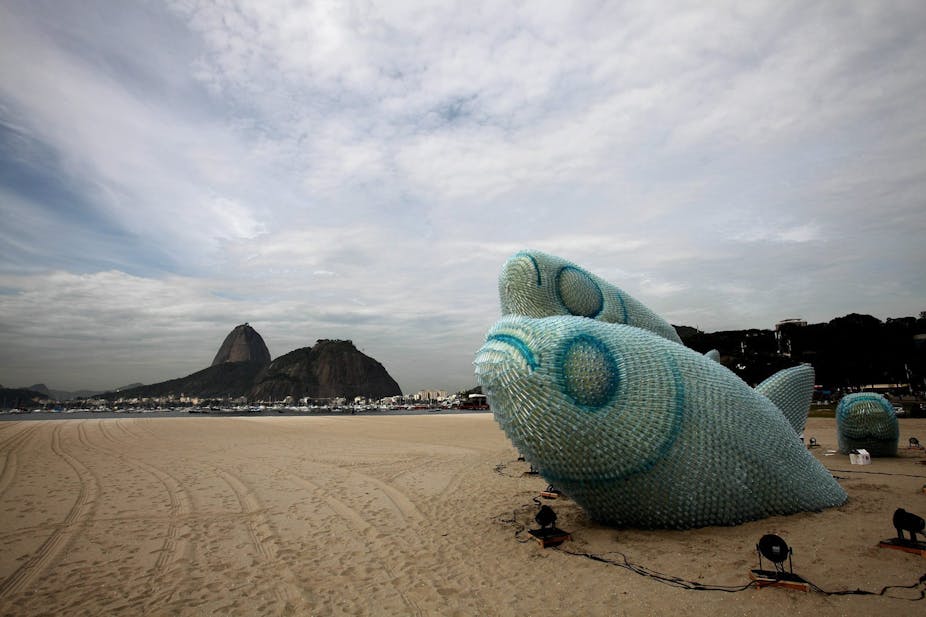On the wall along the massive entrance hall to the Rio+20 Sustainable Development conference venue, there was a painting of an African landscape with the simple words “Keep the oil in the soil and the coal in the hole”.
Across the road there were scores of exhibits by some the world’s leading corporations displaying the latest technologies and management practices designed to contribute towards the elusive goal of sustainable development.
These were just a few of the myriad voices at Rio putting forward their views on the ways to achieve global sustainability. In an impressive display of planetary democracy, over 50,000 participants, including at least 100 heads of state, grappled with one of the most complex challenges ever to face humanity.
Science, too, had a voice at Rio+20. A group of more than 25 Nobel Laureates – prize winners in physics, chemistry, medicine, and economics – has been working over the past four years with some of the world’s leading Earth System scientists to explore the implications for our future of the growing human pressure on the earth’s environment.
Their message was clear, simple and powerful. A healthy and well functioning global environment underpins the economy and is essential for our well-being, and yet our current development pathways are eroding our own life support system from under our feet. Climate change is the most well-known symptom, but the rapid loss of biodiversity is just as serious.
Drawing on recent research from the Earth System science community, the Laureates emphasized that there are intrinsic limits to the amounts of resources and environmental services that the planet can provide to support humanity. The concept of planetary boundaries captures this increasingly solid scientific understanding, and provides the tools to translate the science into policy. The goal to limit global warming to a rise of no more than 2 degrees Celcius over the pre-industrial level, corresponding to a concentration of carbon dioxide in the atmosphere of about 450 parts per million, is an example of a planetary boundary.

Last year at a symposium, appropriately held in Stockholm, Sweden, the Nobel Laureates met the UN Secretary-General’s High-Level Panel on Global Sustainability, of which Australia’s former Foreign Minister, Kevin Rudd, was a member. The Panel and Laureates agreed that respecting planetary boundaries is a necessary condition for global sustainability and embedded the concept in their report, a major input into the Rio+20 conference.
However, something was lost on the road from Stockholm to Rio. While the draft Rio+20 conference statement put forward many extremely important goals for sustainable development, such as eliminating poverty, achieving gender equity and reducing the inequalities between countries, the global environment was shoved into the background, virtually invisible in a mass of words that seemed to capture every country’s and interest group’s favourite issue.
There were some notable exceptions to the silence on the global environment. Actions speak louder than words (and there were plenty of the latter in Rio!). Australia’s pricing of carbon pollution and its recent significant increase in marine protected areas, which incidentally address two of the most important planetary boundaries, did not go unnoticed. It was good to go to Rio from a country that is walking the talk.
Many of the scientists at the Rio+20 conference were dismayed to see references to planetary boundaries disappear from the official conference statement. Last-ditch efforts were made to get the concept reinstated. But, in fact, the dropping of planetary boundaries from the statement is, ironically, a good sign that the transformation to a low-carbon, biodiversity-friendly future is gathering momentum.
Conference statements like that from Rio+20 invariably contain long lists of goals, aspirations and exhortations. The list is long because the items are either already well known and universally accepted – like eliminating poverty – or are non-threatening to the current development approach. The concept of planetary boundaries challenges the belief that resources are either limitless or infinitely substitutable. It threatens the business-as-usual approach to economic growth.
The fact that reference to planetary boundaries was excluded from the conference statement is a counterintuitive sign that the concept is being taken very seriously and has indeed gained enough traction to be threatening to the status quo. Had planetary boundaries remained in the statement, the most credible interpretation is that they would join a growing list of nice-sounding goals that are included but never achieved in the end.
Planetary boundaries will not go away. The intrinsic limits to the amount of resources and environmental services that humanity can extract safely from the Earth System cannot be eliminated by wishful thinking, denial, or omission from official sustainable development conference statements. It is simply the nature of the planet we inhabit.
Science will continue to improve our understanding of the planet’s boundaries. But rather than retarding further human development, the concept can help to redirect the creative and innovative human spirit – and there was plenty of that evident at Rio – towards continuing advances in prosperity and well-being, but now within the safe operating space defined by Earth itself.
The Rio+20 conference certainly didn’t deliver the grand breakthrough that would rapidly deliver global sustainability – and it was never going to – but by bringing a critical but contested issue like planetary boundaries explicitly on the table it was a significant step forward in the long journey towards living prosperously, equitably, and well within the Earth’s limits.
Comments welcome below.

